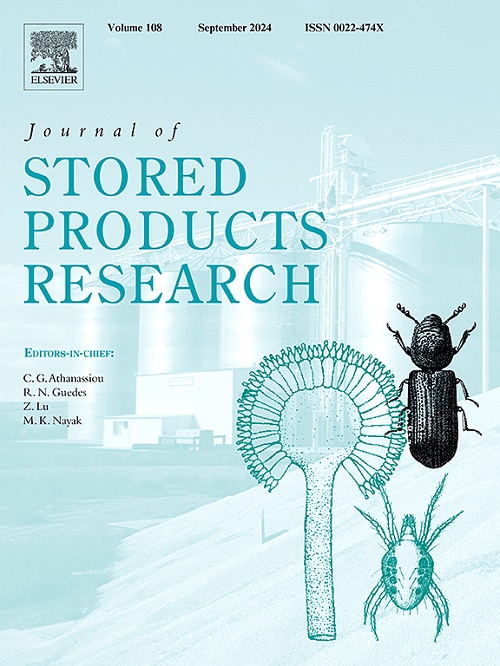Transcriptomic insights into detoxification and mitochondrial responses of Tribolium castaneum (Coleoptera: Tenebrionidae) to carbonyl sulfide exposure
IF 2.7
2区 农林科学
Q1 ENTOMOLOGY
引用次数: 0
Abstract
Carbonyl sulfide (COS) is a novel grain fumigant effective against several stored-grain pests, including Tribolium castaneum. While COS has demonstrated high toxicity and broad efficacy, the molecular mechanisms underlying COS toxicity remain largely unexplored. In this study, we analyzed the transcriptome in the malpighian tubules and fat body tissues of adult T. castaneum upon COS fumigation. Our analysis identified 3034 and 2973 differentially expressed genes (DEGs) in the malpighian tubules and fat body, respectively. Key DEGs associated with insecticide detoxification, mitochondrial functions, and carbonic anhydrase (CA) activity were significantly expressed between the COS-treated and control groups. Functional annotation and pathway analyzes were performed on these DEGs, and 24 genes were selected for further validation, including those encoding cytochrome P450 (P450s), esterases (ESTs), glutathione-S-transferase (GST), UDP-glucuronosyltransferases (UGTs), ATP-binding cassette transporters (ABCs), ATP synthase, NADH dehydrogenase (NADH), succinate dehydrogenase (SDH), cytochrome c oxidase (COX) and CA enzymes. We analyzed the impact of acetazolamide, a CA inhibitor, on the survival rates of T. castaneum larvae and adults following COS exposure, suggesting that acetazolamide may reduce COS toxicity by inhibiting CA activity. Furthermore, RNA interference (RNAi) was employed to silence the CA3 gene, exploring its role in CA-mediated COS metabolism in T. castaneum. This study presents the first comparative transcriptome investigation of the malpighian tubules and fat body in T. castaneum, enhancing our understanding of the molecular basis of COS toxicity and its potential as an effective alternative for control of this significant storage pest.
黄颡鱼(鞘翅目:拟甲科)对羰基硫化物暴露的解毒和线粒体反应的转录组学研究
羰基硫化物(COS)是一种新型的粮食熏蒸剂,对几种储粮害虫有较好的防效。虽然COS已被证明具有高毒性和广泛的疗效,但COS毒性的分子机制仍未被充分研究。在本研究中,我们分析了COS熏蒸后成年castaneum的马尔比氏小管和脂肪体组织的转录组。我们的分析分别在马氏小管和脂肪体中鉴定出3034个和2973个差异表达基因(DEGs)。与杀虫剂解毒、线粒体功能和碳酸酐酶(CA)活性相关的关键deg在cos处理组和对照组之间显著表达。对这些DEGs进行了功能注释和途径分析,并选择了24个基因进行进一步验证,包括编码细胞色素P450 (P450)、酯酶(ESTs)、谷胱甘肽- s转移酶(GST)、udp -葡萄糖醛基转移酶(UGTs)、ATP结合盒转运蛋白(abc)、ATP合成酶、NADH脱氢酶(NADH)、琥珀酸脱氢酶(SDH)、细胞色素c氧化酶(COX)和CA酶的基因。我们分析了CA抑制剂乙酰唑胺对COS暴露后castaneum幼虫和成虫存活率的影响,表明乙酰唑胺可能通过抑制CA活性来降低COS毒性。此外,采用RNA干扰(RNAi)沉默CA3基因,探讨其在甘蔗中ca介导的COS代谢中的作用。本研究首次对castaneum的马尔比氏小管和脂肪体进行了转录组比较研究,加深了我们对COS毒性的分子基础的理解,并进一步了解了COS作为一种有效的替代方法来控制这种重要的储存害虫的潜力。
本文章由计算机程序翻译,如有差异,请以英文原文为准。
求助全文
约1分钟内获得全文
求助全文
来源期刊
CiteScore
5.70
自引率
18.50%
发文量
112
审稿时长
45 days
期刊介绍:
The Journal of Stored Products Research provides an international medium for the publication of both reviews and original results from laboratory and field studies on the preservation and safety of stored products, notably food stocks, covering storage-related problems from the producer through the supply chain to the consumer. Stored products are characterised by having relatively low moisture content and include raw and semi-processed foods, animal feedstuffs, and a range of other durable items, including materials such as clothing or museum artefacts.

 求助内容:
求助内容: 应助结果提醒方式:
应助结果提醒方式:


